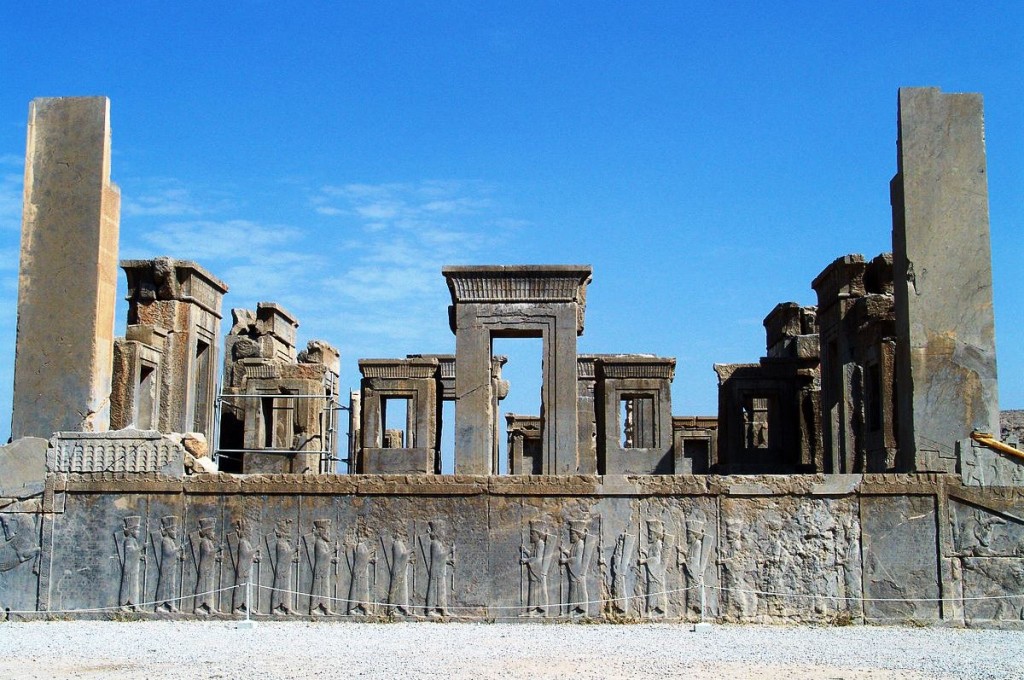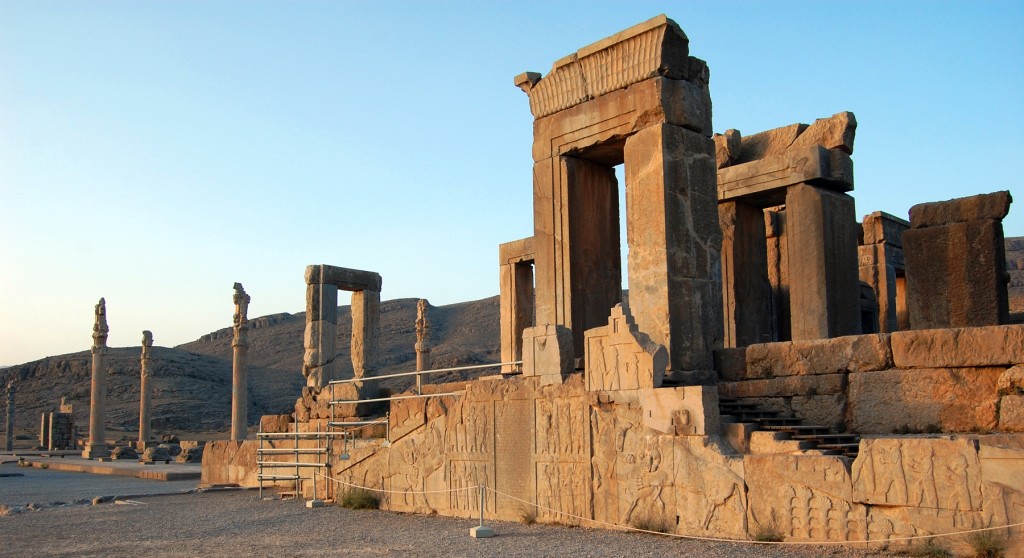Persepolis is the Greek name for the ancient city of Parsa, located 70 miles northeast of Shiraz in present-day Iran. The name Parsa meant “City of The Persians” and the magnificent palace complex at Persepolis was founded by King Darius which construction started at the site in 518 BCE. Darius made Parsa the new capital of the Persian Empire, in its place of Pasargadae, the old capital and burial place of King Cyrus the Great.
Persepolis visualized was a majestic showplace and the seat of his vast Achaemenian Empire, arrogantly proclaimed his achievement Due to its remote location in the mountains, nevertheless, travel to Parsa is an arduous task during the rainy season of the Persian winter when paths turned to mud and the city was used mostly in the spring and summer warmer seasons.
The great city of Persepolis was built in terraces up from the river Pulwar to rise on a larger terrace of over 125,000 square feet, partly cut out of the Mountain Kuh-e-Rahmet (“the Mountain of Mercy”) in the plain of Marv Dasht about 850 kilometers south of the present capital city of Tehran and about 50 kilometers north of Shiraz.
To create the level terrace, huge depressions were filled with soil and heavy rocks which were then secured together with metal clips; upon this ground, the first palace at Persepolis gradually grew. The magnificence of Persepolis lasted only two centuries, though, short-lived; but its royal audience halls and residential palaces perished in flames when Alexander the Great conquered and looted Persepolis in 330 B.C. and, carried away its treasures on 20,000 mules and 5,000 camels (According to Plutarch).
The site was identified in A.D 1620, and following several centuries countless people traveled to Persepolis and the ruins of its Achaemenid palaces. Persepolis Palace Complex, Structures, Reliefs, and Inscriptions mainly deal with the architecture of the palace complex, and its buildings and embellishing reliefs.
An inscription carved on the southern face of the Terrace proves that King Darius was the founder of Persepolis and its work began about 518 B.C., though the marvelous task was not completed until about 100 years later by Artaxerxes I. Before any of the buildings could be erected, considerable work had to be done. This mainly involved cutting into an irregular and rocky mountainside in order to shape and raise the large platform and to fill the gaps and depressions with rubble.
King Darius planned an impressive complex of palaces not only as the seat of government but also, primarily, as a showplace and a spectacular center for the receptions and festivals of the Achaemenian kings and their empire. King Darius lived long enough to glimpse only a small part of his plans executed.
His brilliant and lavish ideas were taken up and followed by his son and successor Xerxes, who said: “When my father Darius went the throne, I became king on my father’s throne. After I became king what had been done by my father, that I also (did), and other works I added.” Actually, the Persepolis is mostly the work of Xerxes, according to an excavated foundation inscription.
Persepolis platform on the northern part of the Terrace, consisting mainly of the Audience Hall of the Apadana, the Throne Hall, and the Gate of Xerxes, represented the official section of the Persepolis complex, accessible to a restricted public. The other part held the Palaces of Darius and Xerxes, the Harem, the Council Hall, and such.
The Apadana is the largest and most magnificent building started by Darius and finished by Xerxes that was mainly used for great receptions by the kings. Thirteen of its seventy-two columns still stand on the enormous platform to which two monumental stairways, on the north and on the east, give access.
They’re decorated with rows of gorgeously executed reliefs showing scenes from the New Year’s festival and processions of representatives of twenty-three subject nations of the Achaemenid Empire, with court notables and Persians and Medes, followed by soldiers and guards, their horses, and royal chariots.
Delegates in their native attire, some completely Persian in style, normally carry gifts as tokens of their loyalty and as an honor to the king. These gifts include silver and gold vessels and vases, jewelry, weapons, woven fabrics, and animals from the delegate’s own countries. Although the overall arrangement of scenes gives the impression of repetition, there are marked differences in the designs of garments, headdresses, hairstyles, and beards that offer each delegation its own distinctive character and make its origin distinctive.
Another means by which the design achieves diversity is by separating various groups or activities with stylized trees or by using these trees alone to form ornamental bands. There’s also an intentional usage of patterns and rhythms that, by repeating figures and groups, conveys a magnificent ornamental impression.
Next to the Apadana, There’s a Throne Hall the 2nd largest building of the Persepolis Terrace. The Throne Hall “Hundred-Column Hall”, was begun by Xerxes and finished by his son Artaxerxes I. Its eight stone doorways are decorated on the south and north with reliefs of throne scenes and on the east and west with scenes depicting the king in combat with monsters. Moreover; the northern portico of the building is bordered by two colossal stone bulls.
At the beginning of Xerxes’ reign, the “Throne Hall” was used primarily for receptions for representatives of all the subject nations of the empire. Later on, when the Treasury proved to be too small, the Throne Hall also served as a storehouse and, above all, as a place to display more adequately objects, both tribute and booty, from the royal treasury. Concerning this, Schmidt wrote of the striking parallel in a modern example of a combined throne hall and palace museum where the Shah of Iran stores and exhibits the royal treasures in rooms and galleries adjoining his throne hall in the Gulistan Palace at Teheran.
Adjacent to the Throne Hall is the Treasury, part of which served as an armory and especially as a royal storehouse of the Achaemenian kings. The tremendous wealth stored here came from the booty of conquered nations and from the annual tribute sent by the inhabitants of the empire to the king on the occasion of the New Year’s feast.
Before the Throne Hall was finished, the most spacious room of the Treasury was used as a Court of Reception. Hence; two large stone relieves were discovered here that attested to its function. These depict Darius I, seated on his throne, being approached by a high dignitary whose hand is raised to his mouth in a sign of respectful greeting. Behind the king stands Crown Prince Xerxes, followed by court officials.
The Palace of Darius actually has twelve columns supporting the roof of the central hall from which three small stairways descend. Relieves on these stairways depict servants coming up the steps carrying animals and food in covered dishes to be served at the king’s tables. On the eastern and western doorjambs are relieves showing the king in formal dress leaving the palace, followed by two attendants; relieves on the northern and southern doorways depict the king in battle with monsters.
The Palace of Xerxes is almost double as large as that of Darius, and shows many related decorative features on its stone doorframes and windows, excluding two large Xerxes inscriptions on the eastern and western doorways. In its place of showing the king’s combat with monsters, these doorways represent servants with ibexes.
Unluckily, all relieve in this palace are far less well preserved than those of the Palace of Darius. The Council Hall is the royal apartment is a pompous stairway that led to three entrances. And two were for official purposes, and the third was a secret doorway that led into the Harem.
Related Reading – Discover Magical Rainbow Mountains China




























